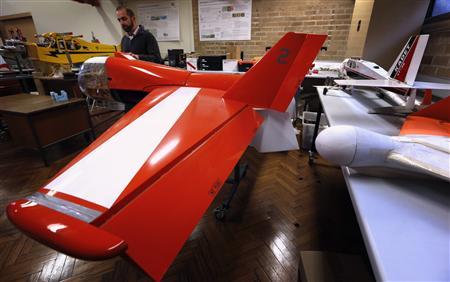(Reuters) – Moving carefully along a row of apple trees, two of Australia’s newest agricultural workers check if the fruit is ripe or the soil needs water or fertilizer.

Meet “Mantis” and “Shrimp”, agricultural robots being tested to do these tasks and more in a bid to cut costs and improve productivity in Australia’s economically vital farm sector, which exported A$39.6 billion ($38.8 billion)of produce in 2012.
Australia is one of the leaders in the field and, with a minimum wage of A$15.96 per hour and a limited workforce, has a big incentive to use robots and other technology such as unmanned aircraft to improve efficiency.
It hopes to tap fast-growing Asian neighbors, where the swelling ranks of the middle class increasingly want more varied and better quality food from blueberries to beef.
“The adoption of new technology is going to be crucial for Australia to maintain its competitiveness in terms of the global agricultural sector,” said Luke Matthews, commodities strategist at the Commonwealth Bank of Australia.
“If we don’t adopt new technology, we can give up on these high-flying ambitions of being the food bowl of Asia.”
Agriculture now accounts for 2 percent of Australia’s gross domestic product, but the government forecasts it could reach 5 percent by 2050. Its growth is particularly important now the once-booming mining sector is slowing.
Australia is the world’s second-biggest wheat exporter and arable farmers are already using specialized technology aimed at improving efficiency, including satellite positioning software to allow farmers to map out land and soil to determine optimal inputs.
Using such technology to optimize the use of fertilizer can boost profitability at grain farms by 14 percent, according to a study by Australia’s Commonwealth Scientific and Industrial Research Organisation.
COLOUR RECEPTORS
A robot effortlessly plucking fruit is some way off, though a range of simpler tasks are within reach to add to existing technology such as automatic steering of harvesters.
Salah Sukkarieh, Professor of Robotics and Intelligent Systems at the University of Sydney and developer of Mantis and Shrimp, says the next phase aims for robots to do increasingly complex jobs such as watering and ultimately harvesting.
“We have fitted them with a lot of sensors, vision, laser, radar and conductivity sensors – including GPS and thermal sensors,” said Sukkarieh, speaking at his laboratory housing a collection of both ground robots and unmanned air vehicles.
The technology could have the biggest application in horticulture, Australia’s third-largest agricultural sector with exports of $1.71 billion in the last marketing year, since a fixed farm layout lends itself better to using robots.
Robots and an unmanned air vehicle that are being developed at the University of Sydney had passed field tests at an almond farm in Mildura, Victoria state, said Sukkarieh.
Propelled by sets of wheels and about the height of a man, the robots were named after the native Mantis shrimp because of the marine crustacean’s 16 different color receptors, capable of detecting up to 12 colors. Humans only have four, three of which pick up colors.
This capacity to recognize color already allows the robots to sense whether fruit is ripe.
The data can then be processed by computer algorithms to determine what action the robot should take. This could be to water or apply fertilizer or pesticides, or to sweep and prune vegetation, and eventually the aim is to harvest the crop.
“If tomorrow we got an apple, orange or tomato farmer that wants a robot to go up and down these tree crops reliably and accurately, we can do that within six months to a year.”
“The question is can we make them more intelligent,” added Sukkarieh, who also sees the technology being attached to standard farm vehicles and foresees a fully automated horticulture farm within 10 years.
BRUISED APPLES
Australian farmers, who depend on seasonal labor for jobs such as picking fruit and vegetables, said they would welcome high-tech help.
“Berry picking by a robot would be difficult but if they could produce a robot, I could make a significant saving,” said Allan Dixon, co-owner of the Clyde River Berry Farm in New South Wales, who typically takes on five people every year.
To get enough agricultural workers, Australia allows in some labor from neighboring Pacific island countries and East Timor, as well as using backpackers on temporary work visas.
Some fruit farmers remain skeptical.
“Apples will always need to be harvested by hand, due to their fragile nature. They bruise very easily,” said Lucinda Giblett, director at Newton Orchards in Western Australia.
“We see no current opportunities offered by agricultural robots. Even as a pruning device, application is very limited,” added Giblett
PRODUCTIVITY
Further productivity gains will be needed if Australia is to reach its target of being the main food supplier to Asia.
A 2011 study by the Australian Bureau of Agriculture and Resource Economics and Sciences said around two-thirds of the increase in the monetary value of agricultural production in the last 50 years in the country was down to gains in productivity
Another survey by the Grains Research and Development Corporation showed 67 percent of respondents in 2011 used auto-steer technology to guide machinery such as harvesters and sprayers, up from 47 percent in 2008.
Obstacles to using more technology remain, however, including the cost of buying or renting equipment and slower growth in research and development spending. Some studies show growth in the use of satellite imagery and soil mapping has stagnated in Australia and the United States in recent years.
Regardless of whether it can meet its targets to supply more food to Asia, Australia is expected to play a big role in global food security by being one of the test beds for new ways to produce food more efficiently in often harsh conditions.
(Writing by Ed Davies; Editing by Michael Urquhart)





